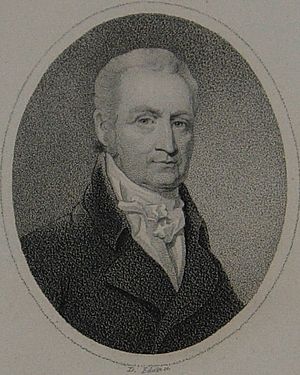John Crawford (physician) facts for kids
Quick facts for kids
John Crawford
|
|
|---|---|
 |
|
| Born | 3 May 1746 Northern Ireland |
| Died | 9 May 1813 Baltimore |
| Occupation | Physician |
John Crawford (born May 3, 1746 – died May 9, 1813) was an important doctor who helped bring vaccination to America. He also did amazing research into what causes diseases. He was born in Northern Ireland and became a physician, just like his brother Adair, who was a famous doctor in London.
Contents
Early Life and Medical Training
John Crawford began his studies at Trinity College Dublin when he was 17. After that, he went to Leiden University in the Netherlands, where he earned his medical degree. This was a big step in his journey to becoming a doctor.
Adventures as a Ship's Surgeon
After finishing his studies, John Crawford worked as a surgeon on two long voyages to the East Indies. He was part of the East India Company, which was a powerful trading company. Around 1778, he got married. Soon after, he became a surgeon at a Naval Hospital on the island of Barbados. This was a very important job.
In 1780, a terrible hurricane hit Barbados. Dr. Crawford worked tirelessly to help the sick and injured. He gave out medicines and aid without asking for any payment. In 1781, he returned to England because he wasn't feeling well. Sadly, his wife passed away during the trip.
Later, in 1790, the Dutch government hired him. He became the chief surgeon for the colony of Demerara in South America. There, he was in charge of a military hospital that had many beds for patients.
Contributions in Baltimore
In 1796, Dr. Crawford moved to Baltimore, a city in America. He played a big part in starting several important organizations there.
Helping the Community Grow
He helped create the Baltimore General Dispensary in 1801, which was a place where people could get medical care. He also supported the building of a penitentiary (a type of prison) in 1802. He helped establish the Bible Society and the Baltimore Library, showing his commitment to education and community welfare.
Teaching and Medical Leadership
Dr. Crawford also taught natural history at the College of Medicine in 1811 and 1812. He was a highly respected doctor. He held many important positions, like being an examiner and a member of committees for medical publications. He also advised the Board of Health and the City Hospital.
Bringing Vaccination to America
One of his most notable achievements was being among the first in America to use vaccination. He started using vaccine virus in the summer of 1800. This was around the same time that Dr. Waterhouse in Massachusetts also began using it. Many people credit Dr. Waterhouse with the first use in the Western Hemisphere, but Dr. Crawford was right there with him. Dr. Crawford also wrote many valuable medical articles for journals of his time.
Amazing Research on Disease Causes
What really makes John Crawford stand out is his incredible research into what causes diseases. As early as 1790, he came up with a groundbreaking idea all on his own.
The Idea of Living Germs
He believed that tiny, living creatures, which he called "animalcula," could enter the human body. Once inside, these tiny creatures would grow and cause diseases. This idea is known as the germ theory, and it was very new at the time.
Dr. Crawford studied nature and gathered a lot of evidence to support his theory. Even though many people didn't believe him and it made his professional life harder, he stuck to his ideas with strong conviction.
Foresight About Tiny Organisms
He pointed out that humans, despite being special, follow the same natural rules as animals. He talked about "universal parasitism," meaning that tiny organisms can live on or in other living things. He argued that even though these tiny "animalcula" couldn't be easily seen then, they weren't impossible to find. He predicted that people would eventually discover them.
He compared the "seeds" of disease to plant seeds. Just as a specific plant seed grows into only one type of plant, he believed each disease "seed" caused only one specific disease. He didn't just have these ideas; he used them to think about how to prevent and treat illnesses.
Publishing His Bold Ideas
Because his ideas were so new and unpopular, he couldn't publish them in medical journals. Instead, he shared his opinions in a non-medical newspaper called The Baltimore Observer. His articles appeared in 1806 and 1807 under the title "Quarantine."
Historians believe that John Crawford independently discovered this theory. He was one of the first people in history to study it in a truly scientific way.
Later Life and Legacy
John Crawford passed away in Baltimore on May 9, 1813, after a short illness. He was buried in Westminster churchyard.
He had one daughter who married Maximilian Godefrey, a famous French architect. They later moved to France. Dr. Crawford's large collection of reference books is now kept at the University of Maryland. His writings can be found in various medical journals and historical records from his time.
Dr. Crawford was also a well-known freemason. In his letters to Thomas Jefferson, he shared his thoughts on the gradual freeing of slaves.
See also
- History of malaria
- Mosquito-malaria theory
![]() This article incorporates text from American Medical Biographies, by Eugene F. Cordell, a publication from 1920 now in the public domain in the United States.
This article incorporates text from American Medical Biographies, by Eugene F. Cordell, a publication from 1920 now in the public domain in the United States.

